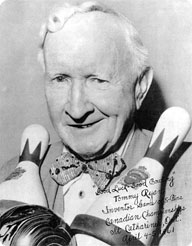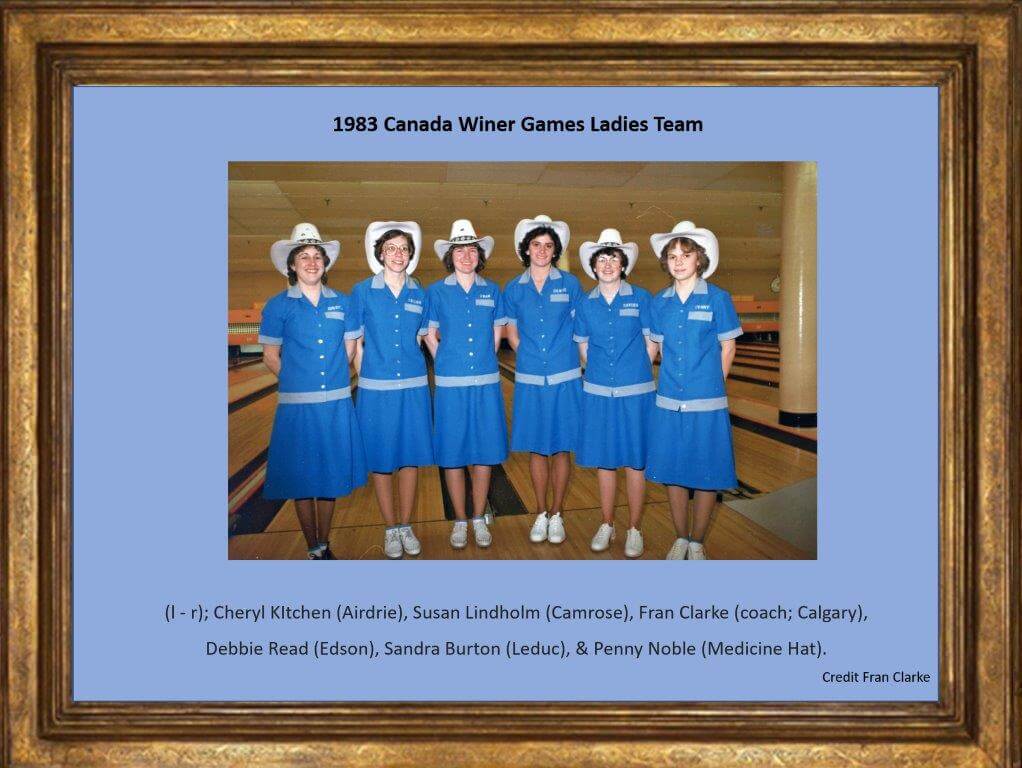Tommy Ryan, Inventer of the sport.

Thomas F. Ryan
(1872 – November 19, 1961)
Tommy Ryan was a Canadian sportsman and entrepreneur who created five-pin bowling.
Born in Guelph, Ontario, Ryan moved to Toronto at age 18. A natural baseball pitcher, he received an offer from the Baltimore Orioles, but turned it down in favour of a steady job in Toronto.
Ryan had been running a pool hall on Yonge Street and in November 1909 co-founded the Toronto Bowling Club above a store at Yonge and Temperance Street.
Customer complaints about the size and weight of the tenpin bowling balls and the game being far too strenuous, led Ryan to experiment. He had his father whittle down five of the larger tenpins on a lathe, to approximately 3/4 of their original size. He then spaced five of these pins equally on the 36″ (91cm) tenpin triangle. Ryan took a hand sized hard rubber ball (approximately 5″ (12.7cm) in diameter and 3 1/2 lbs. (1.6kg) in weight) and rolled the ball down the tenpin lane at the five pins.
He devised the new game with a smaller ball and only five pins, with a new scoring system. After receiving complaints about the pins bouncing out the window to the street, he added a rubber ring around the pins.
Thus in 1909, the original sport of 5-Pin Bowling was born.
Ryan’s establishment, known as the Toronto Bowling Club, resembled a southern plantation, with potted palm trees, ceiling fans, string orchestra, piano and an immense lunch counter. Ryan insisted that his establishment was a very elite and private club, catering only to the well-to-do, carriage trade of Toronto society.
Even though many changes have taken place through the years, the original concept remains and is enjoyed in hundreds of modern bowling centres by millions of Canadians each year.
In a poll by CBC (Canadian Broadcasting Corporation) Canadians voted for the Greatest Canadian Inventions of All Time, and Tommy Ryan’s invention placed 4th, beating out other Canadian inventions of great import such as the Canadarm, Basketball and the Electron Microscope, among many others.
Ryan purchased the Turtle Hall Hotel in Toronto in April 1914 for $45,000. He later bought the former home of the Massey family, which he converted into an antique gallery and auction house. For decades, he was a judge of the Miss Toronto pageant. He remained a bachelor until he was 82, when he married his secretary.
Ryan died in Toronto at age 89. He was inducted into Canada’s Sports Hall of Fame in 1971. He is buried in the Mount Hope Catholic Cemetery in Toronto, Ontario.
Half hour bowling program from 1967 including Tommy Ryan.
Or try a 2011 video
Canadian Sports Hall of Fame information on 5 Pin Bowling
For more on the History of 5 Pin Bowling
1983 Canada Winter Games.
Contributed by Fran Clarke
1983 was the only time 5 Pin Bowling was included in the Canada Winter Games.

The Ladies team won silver, losing to Ontario in the finals
The Alberta Men’s team was Bruce Morter, Greg Gigliuk, Mike Masse, Randy Clarke , Jim Tanouye, & coach Bill Douglas. They finished 4th.
CHRONOLOGICAL HISTORY OF FIVE PIN BOWLING
| 1909 | Thomas F. (Tommy) Ryan invents 5 Pin Bowling in Toronto, Ontario. Original Pin Count is established as “4-2-1-3-5”. |
| 1910 | First 5 Pin Bowling League was formed at Ryan’s Toronto Bowling Club. |
| 1912 | Rubber band was added to the Pins. |
| 1918 | Alfred Shrubb of Toronto bowls first (recognized) 400 game. |
| 1921 | First perfect “450” game bowled by Bill Bromfield in Toronto, Ontario. |
| 1921 | First Ladies’ 5 Pin Bowling League started by Marion Dibble in Toronto, Ontario. |
| 1922 | First inter-city match between Toronto and Montreal using a telephone hook-up. |
| 1923 | Winnipeg’s Charles Gibson introduces 5 Pin Bowling to Western Canada. |
| 1927 | First 5 Pin Bowling organization “Canadian Bowling Association” (CBA) formed in Toronto, Ontario. T.J. (Tommy) Simpson elected first President. |
| 1928 | First “Official 5 Pin Rule Book” printed by the C.B.A. |
| 1930 | Western Canada adopts own scoring system. Pin Values equal 1-4-5-3-2. |
| 1932 | First sanctioned perfect “450” game bowled by Joe Heenan of Toronto, Ontario. |
| 1935 | Blind bowlers’ leagues introduced in Western Canada. |
| 1935 | C.B.A. creates Ladies Section. Mabel MacDowell elected first President. |
| 1938 | N. Berry of Winnipeg records first perfect “450” game under Western Canada scoring system |
| 1940 | Tillie Hosken of Toronto becomes first female bowler to roll a perfect “450” game. |
| 1944 | Western Canada 5 Pin Bowling Association (WCFBA) was formed in Regina, Saskatchewan. Bill Hawrylak elected first president. |
| 1952 | National 5 Pin Count (2-3-5-3-2) introduced by Charlie Hill (President of the CBA) and adopted only by Western Canada. |
| 1953 | First Canadian Championship (East vs. West) conducted in Regina, Saskatchewan. Deaf bowler, Tommy Mallon wins Men’s Singles. Regina wins Men’s Team event. |
| 1953 | C.B.A. changes name to Ontario Bowling Council. |
| 1957 | First youth organization formed, Canadian Junior Bowling Congress. |
| 1957 | First automatic pinsetting machine introduced. |
| 1958 | First “Pepsi-Cola High School Championships” held in Alberta. |
| 1959 | Entire country uses National 5 Pin Count as Eastern Canada adopts the “2-3-5-3-2” system. |
| 1959 | 5 Pin Bowling introduced to international markets in British West Indies (Bahamas) and Scotland. |
| 1961 | Founding father Tommy Ryan passes away on Nov. 19th. |
| 1962 | Lane Certification and Tournament Sanctioning introduced. |
| 1963 | Bowling Proprietors’ Association of Canada (Bowl Canada) formed. |
| 1963 | Bowl Canada introduces Youth Bowling Council (YBC) to replace the defunct Canadian Junior Bowling Congress. |
| 1963 | First automatic string pinsetter introduced. |
| 1964 | First provincial Master Bowlers’ Association formed in Ontario. |
| 1964 | Canadian Bowling Congress receives charter from federal government. |
| 1965 | Bowlers’ Association of Canada formed. |
| 1965 | Bowling pin measurements standardized. |
| 1965 | Carling O’Keefe Breweries obtained as Canadian Championships sponsor. |
| 1967 | Counter (Blow) Pin abolished by C.B.C. |
| 1968 | Eastern Canada adopts the no-counter pin ruling but Western Canada disagrees and opts out of C.B.C. and Canadian Championships from 1969 to 1971. |
| 1970 | Master Bowlers’ Association of Canada formed. |
| 1971 | Tommy Ryan inducted posthumously into Canada’s Sports Hall of Fame. |
| 1971 | Western Canada agrees to abolish Counter Pin rule. |
| 1972 | Western Canada 5 Pin Bowling Association (WCFBA) disbands in favour of Provincial Associations. |
| 1972 | Canadian 5 Pin Bowling Championships restored. |
| 1972 | Bowl Canada introduces National Golden Age Bowlers’ Club. |
| 1975 | Government survey reveals 680,000 bowlers in 20,000 leagues across Canada. 102 Local (Zone) Associations with 105,000 members affiliated with the C.B.C. |
| 1975-1978 | Between 1975 and 1978 the Nationals were called the World 5 Pin Championships |
| 1976 | 5 Pin Bowling “Standards & Specifications” Committee formed. |
| 1976 | National 5 Pin Bowling “Instruction & Coaching” Program introduced by the Master Bowlers’ Association of Canada. |
| 1977 | 5 Pin Bowling included in Ontario Winter Games for the first time. |
| 1978 | Canadian Bowling Congress and Bowlers’ Association of Canada dissolve to form new national body, the Canadian 5 Pin Bowlers’ Association (C5PBA). |
| 1980 | First International Bowling Cup competition held in Manila, Philippines. Canada & Philippines participate. |
| 1983 | 5 Pin Bowling participates in Canada Winter Games in Chicoutimi, Quebec. |
| 1983 | Hiram Walker Distilleries Ltd. is welcomed as the new national sponsor of the Hiram Walker “Special Old” High-Low Doubles and League Executive Championships. |
| 1983 | 2nd International Bowling Cup held in Toronto, Ontario with Canada, Philippines, Argentina and the United States represented. |
| 1984 | 5 Pin Bowling returns to national television on CBC’s Championship 5 Pin Bowling. |
| 1984 | 5 Pin Bowling celebrates its 75th birthday. |
| 1986 | Canadian 5 Pin Bowlers’ Association grows to 100 Local (Zone) Associations with 165,000 affiliated members. |
| 1987 | National 5 Pin Bowler Ranking introduced by the C5PBA. |
| 1990 | Rules changed to allow the use of personal bowling balls. |
| 1995 | Government statistics report 521,000 Canadians participate regularly in 5 Pin Bowling (37% male vs. 63% female). |
| 2005 | National Youth Bowling Council changes it’s name to Youth Bowling Canada |
| 2006 | CBC’s poll of the Canadian Public places 5 Pin bowling as the 4th Greatest Canadian Invention of All Time. |
| 2009 | 5 Pin bowling celebrates it’s Centennial Anniversary and 100 years of excellence in Canadian Sport. |
